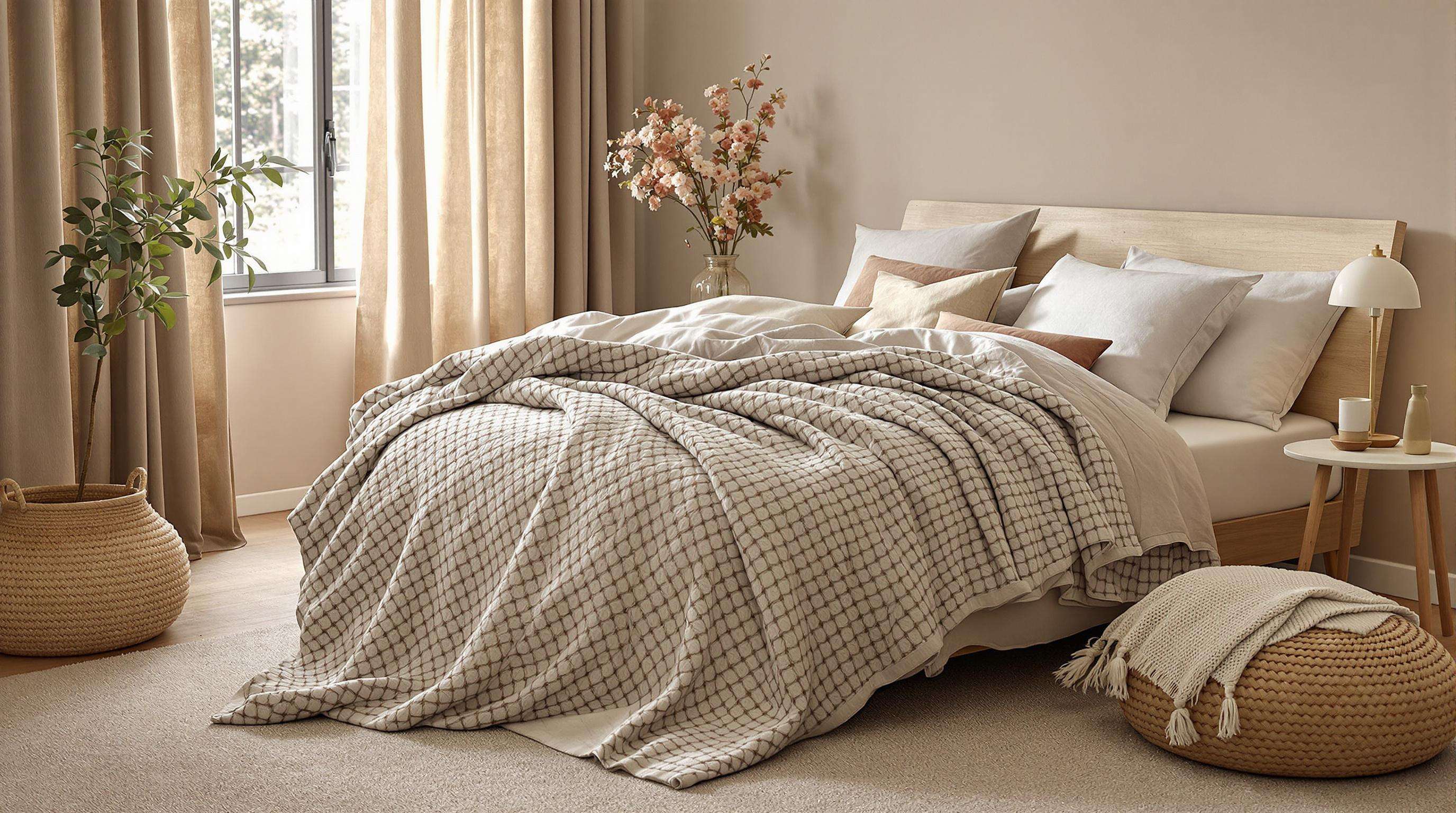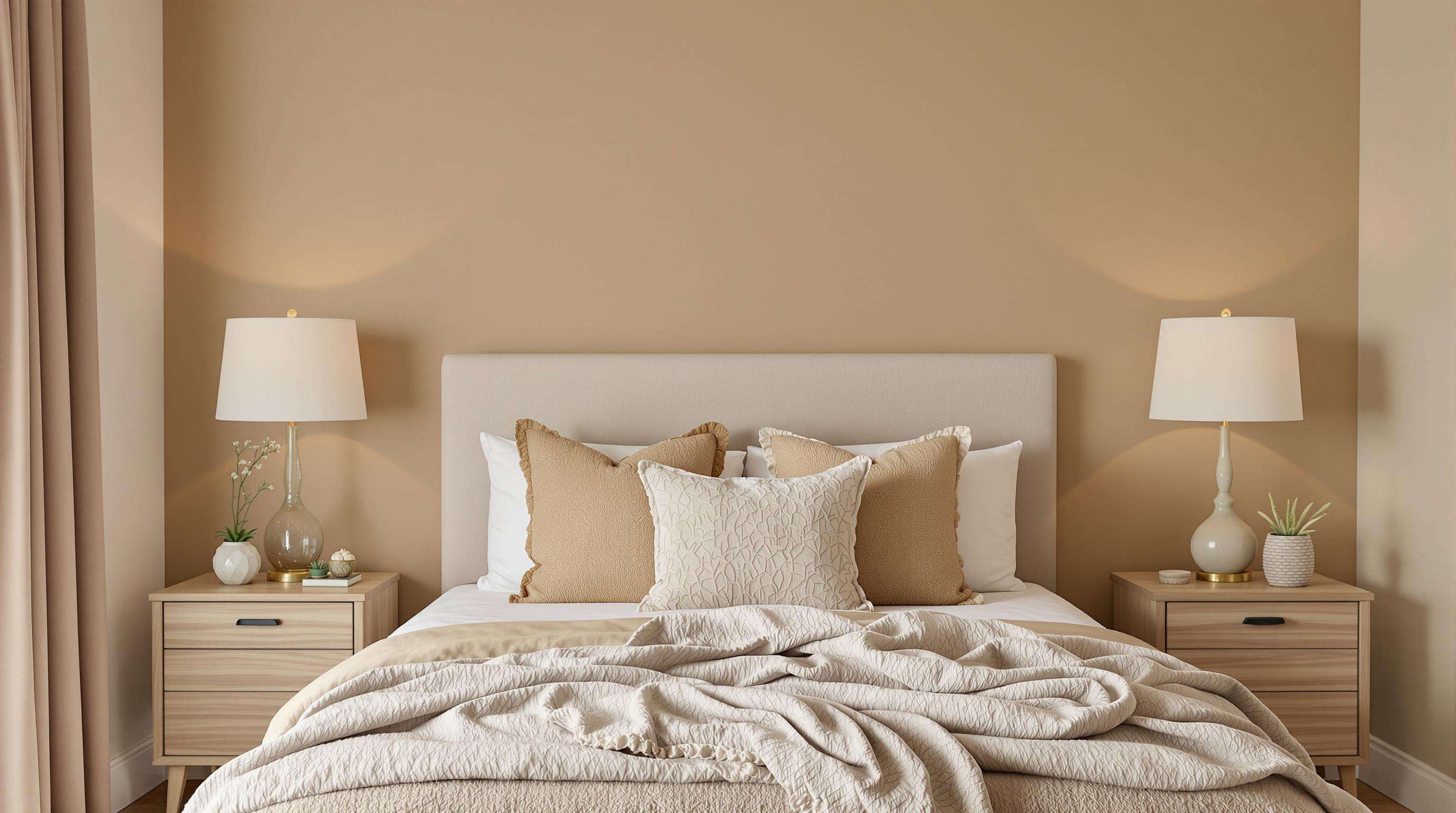Rooms decorated with cozy soft stuff seem to cut down on those late night stress reactions by about 23% when compared to barebones spaces according to Livingetc from last year. The fabrics themselves offer what some call "sensory comfort" which actually works on our minds to soothe nerves, helping bring down pulse rates and blood pressure levels. Organic bedding made with breathable materials helps maintain this calming effect because it pulls away sweat and keeps people from getting too hot at night. Plus there's something else going for it too these natural fibers cut allergen problems nearly in half versus regular synthetics, mainly because of stuff like cotton grown without chemicals.
Getting the right temperature while sleeping really makes a difference when trying to get good rest, and what we choose to sleep on matters quite a bit. Recent research from last year showed something interesting about organic linen sheets they actually cut down on those annoying middle-of-the-night wake ups by around 30 percent during hot summers. When winter comes around, people who use brushed cotton duvets stay warmer too these things hold onto heat about 22% better than regular polyester ones and don't leave us feeling damp under the covers. Plus there's another benefit worth mentioning natural fabrics seem to be friendlier to our body clocks because they don't release all those chemicals that synthetic materials do, which might mess with how our bodies produce melatonin at night.
The feel of things really matters when it comes to how our brains relax. Take velvet for instance its thick texture seems to trigger those calming parts of the nervous system, making people feel secure and at ease. Smooth linen fabrics work differently they can cut down on overstimulation for folks who experience sensory sensitivities, according to research from the American Academy of Pediatrics back in 2022 showing almost a 20% reduction in overload symptoms. Mixing up fabric weights makes all the difference too. Pairing light bamboo sheets with chunky wool blankets gives that comforting layering effect everyone craves both physically and emotionally without creating visual chaos in the room.

Start by choosing warm gray walls, maybe some creamy ivory accents, or those soft taupe tones that just seem to calm the eyes down. Throw in a chunky linen duvet on top of those crisp percale sheets we all love so much these days. And don't forget that cozy cable knit blanket tucked down at the bottom of the mattress area. The way those different textures play together really makes the space feel deeper without losing its peaceful vibe. Matte finishes next to all those interesting fabrics create this balance that feels both calming and welcoming when someone walks into the room.
Adding breathable organic stuff to the bed area makes sense for those wanting both comfort and sustainability. Think about bamboo blend pillowcases or maybe some hemp woven lumbar pillows they look great and feel amazing too. Throw a thick wool blanket over that velvet bench we got last month, and definitely get a jute rug with different height piles it adds texture and warmth to any room. Changing out fabrics as seasons change works wonders. Light cotton quilts during hot months, then switch to faux fur throws when it gets cold outside. This keeps things interesting all year round and maintains that cozy factor everyone loves.
When working with textures in different areas, stick to about three main materials that work well together. Think something like pairing smooth satin curtains next to those rustic wooden nightstands we all love, and throw in a medium weight texture somewhere, maybe a braided wool rug would do nicely. To keep everything looking cohesive, try sticking with one main color throughout the space. Warm caramel tones look great on leather ottomans, woven baskets, and even ceramic lamps. This creates that seamless flow everyone wants without making the room feel too matchy matchy. The key is finding pieces that complement rather than compete with each other.

Soft beiges, those warm clays, and honey colored taupes are really taking over when it comes to creating bedrooms that help people actually sleep. A recent survey from Homes & Gardens in 2024 found something interesting - around three out of four interior designers are going for these earthy tones instead of brighter colors. Why? Well, apparently they cut down on visual clutter by about 40% compared to those bold color combinations we see everywhere else. The colors themselves remind us of things found in nature linen, beach sand, maybe even that rough wood you find at the hardware store. There's just something calming about them that makes our brains think safe and simple. For extra comfort, try mixing matte surfaces with fabrics that have texture like wool throws or cotton blankets that feel nice against skin but won't overwhelm anyone trying to relax.
Terracotta, ochre, and sage green pair really well with warm neutral colors when trying to create spaces that feel grounded and cozy. According to some design trends coming out in 2025 from Yahoo, people actually react physiologically to these earth tones. The colors seem to slow down heartbeats quite a bit in lab tests, around 12% on average. For adding depth without making rooms feel cramped, try using richer shades like burnt umber or forest green on things such as throw pillows or area rugs against lighter walls. When working with small bedrooms though, keep those earthy colors to about a quarter to a third of what's visible overall. This helps maintain an airy feel while still getting the relaxing benefits that come with nature-inspired hues.
When designers want to mix luxury with functionality, they often turn to materials such as velvet, fake fur, and brushed cotton. Velvet brings a certain depth and cozy feel to any space, which is why many people choose it for those throw pillows or that special chair in the living room. Fake fur offers something really nice to touch while being surprisingly low maintenance too since most can go right into the washing machine without losing their shape or quality throughout all seasons. And let's not forget about brushed cotton either. This fabric manages to stay soft yet strong over time, keeping that comforting nap texture intact even after countless washes in the laundry room.
Breathable organic bedding is foundational to sleep wellness. Unbleached cotton and linen wick moisture 40% faster than synthetic blends, helping regulate body temperature. Hypoallergenic and free from harsh chemicals, these materials contribute to more consistent, uninterrupted sleep, as supported by findings in the Sleep Health Journal (2023).
Thermal performance depends on fabric construction. Heavyweight velvet resists drafts, while lightweight percale weaves allow airflow for summer cooling. Wool’s natural crimp traps air, retaining heat 25% longer than acrylic. Open-knit cotton promotes breathability, preventing overheating in warmer months.
Linen duvet covers soften over time, developing a relaxed elegance that pairs beautifully with rattan bed frames. Jute rugs offer textural contrast to plush upholstery, their coarse weave grounding furniture like floating nightstands. Woven seagrass baskets add subtle pattern and concealed storage, blending function with natural style.
The right lighting really ties together the peaceful vibe of a bedroom space. Interior design experts noticed in their latest 2025 reports that warm layered lighting options make all the difference when it comes to creating an inviting feel. Think dimmable wall sconces paired with those rustic wooden chandeliers we've been seeing everywhere lately. These elements work wonders with softer materials around the room, from linen curtains fluttering gently at the window to those cozy velvet cushions on the bed. For the actual color temperature, anything below 2700K gives off that comforting golden glow most people find relaxing. And don't forget about good old fashioned task lighting for reading corners or nightstands, which helps prevent those annoying eyes strains after midnight reading sessions. Some adjustable sconces placed strategically next to the headboard area offer just enough light for bedtime stories or late night emails without throwing the whole room into harsh illumination that breaks the tranquil mood everyone wants before sleep.
Furniture with padding does wonders for our comfort levels and actually helps with feeling better emotionally too. Some research indicates that furniture with soft curves and cushiony surfaces can cut down on stress hormones by around 15-20% when compared to those sharp-edged designs we often see. When picking out pieces like bed frames or seating areas, go for materials that breathe well such as raw cotton or hemp fabric covers. These materials help keep things at a comfortable temperature without getting too hot or cold. We've noticed from looking at several homes recently that people who have beds wrapped in linen fabric along with some wool blankets tend to report sleeping better overall, maybe about 20% improvement in how rested they feel after a night's rest. For consistency throughout the space, earth colors work best on tightly woven fabrics since they create a nice balance between what we touch and what our eyes perceive visually across different parts of the room.
What types of soft furnishings improve sleep quality?
Soft furnishings like organic bedding made with breathable materials, velvet, and brushed cotton can improve sleep quality by providing sensory comfort and regulating body temperature.
How do warm, neutral colors in the bedroom affect restfulness?
Warm neutral colors reduce visual clutter and create a calming atmosphere conducive to restfulness, as they remind us of natural elements and help slow heart rate.
Why is breathable organic bedding important for sleep?
Breathable organic bedding helps regulate body temperature, wicks moisture faster, and contributes to uninterrupted sleep due to its hypoallergenic properties and absence of harsh chemicals.
How can lighting enhance the comfort of a bedroom?
Using warm, layered lighting such as dimmable sconces and rustic chandeliers can complement soft textiles, creating a cozy and inviting atmosphere in the bedroom.
 Hot News
Hot News2025-09-04
2025-09-02
2025-09-01
2025-07-08
2025-06-10
2025-11-27